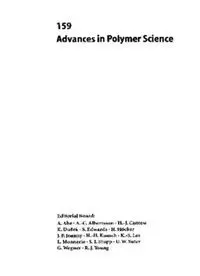
Statistical, Gradient, Block and Graft Copolymers by Controlled/Living Radical Polymerizations PDF
Preview Statistical, Gradient, Block and Graft Copolymers by Controlled/Living Radical Polymerizations
159 Advances in Polymer Science Editorial Board: A. Abe A.-C. Albertsson H.- J.C antow K. DuSek S. Edwards H. Hacker J. F. Joanny H.-H. Kausch K.-S. Lee L. Monnerie S. I. Stupp U. W. Suter G.W egner R. J. Young Springer Berlin Heidelberg New York Barcelona Hong Kong London Milan Paris Tokyo Statistical, Gradient, Block and Graft Copolymers by Controlled/Living Radical Polymerizations By Kelly A. Davis, Krzysztof Matyjaszewski Springer Prof. Krzysztof Matyjaszewski Dr. Kelly A. Davis Dept. of Chemistry Howard Hughes Medical Institute Carnegie Mellon University University of Colorado-Boulder 4400 Fifth Avenue Campus Box 424 Pittsburgh, PA 15213 Boulder, C 0 80309 USA USA E-mail: Editorial Board Prof. Akihiro Abe Prof. Hartwig Hocker Department of Industrial Chemistry Lehrstuhl fiir Textilchemie Tokyo Institute of Polytechnics und Makromolekulare Chemie 1583 Iiyama, Atsugi-shi 243-02, Japan RWTH Aachen E-mail: VI Editorial Board Prof. Samuel I. Stupp Prof. Gerhard Wegner Department of Measurement Materials Science Max-Planck-Institut fur Polymerforschung and Engineering Ackermannweg 10 Northwestern University Postfach 3148 2225 North Campus Drive 55128 Mainz, Germany Evanston, IL 60208-311 3, USA E-mail: Foreword The design and the realisation of well-defined polymer architectures has become an important goal in macromolecular science.T he prerequisite for achieving this goal is the availability of controlled polymerisation reactions. Living anionic polymerisation was the first reaction fulfilling these requirements. Cationic polymerisation only came into play when it was realised that it was possible to create an equilibrium between active and dormant species with the fraction of the dormant species being far superior to that of active ones. A corresponding principle applies to controlled radical polymerisation per- formed in quite a number of modes such as nitroxide-mediated polymerisation (NMP), atom transfer radical polymerisation (ATRP), reversible addition frag- mentation chain transfer (RAFT) or catalytic chain transfer (CCT) reactions. All of these variants of controlled radical polymerisation lead to well-defined archi- tectures with the particular advantage that a much larger number of monomers are suitable and the reaction conditions are much less demanding than those of living ionic polymerisation reactions. Although in controlled radical polymerisation, termination reactions cannot be excluded completely, they are limited in their extent and consequently the mol- ecular weight is controlled, the polydispersity index is small and functionalities can be attached to the macromolecules. These features are indicative of the real- isation of well-defined polymer architectures such as block copolymers, star- shaped and comb-shaped copolymers. The present volume is particularly concerned with the use of the different modes of controlled radical polymerisation for the preparation of copolymers such as random copolymers, linear block copolymers, as well as graft copolymers and star-shaped copolymers. It also presents the combination of controlled radical polymerisation with non-controlled radical copolymerisation, cationic and anionic polymerisation, both of vinyl monomers and cyclic monomers,and ring- opening metathesis polymerisation. The power of controlled radical polymerisation is demonstrated convincingly and the limitations of the synthetic approaches clearly indicated. VIII Foreword Last but not least the volume presents some potential applications for copoly- mers obtained by controlled radical polymerisation. It is expected that the first commercial products will appear on the market this year, giving convincing evi- dence for the importance of controlled radical polymerisation methods. Aachen, March 2002 Hartwig Hocker Advances in Polymer Science Available Electronically For all customers with a standing order for Advances in Polymer Science we offer the electronic form via LINK free of charge. Please contact your librarian who can receive a password for free access to the full articles. By registration at: If you do not have a standing order you can nevertheless browse through the table of contents of the volumes and the abstracts of each article at: There you will find also information about the - Editorial Board - Aims and Scope - Instructions for Authors - Sample Contribution Contents Background .................................................. 2 Copolymers ................................................ 2 Free Radical Polymerization .................................. 3 ControlledILiving Radical Polymerization (CRP) ................ 5 Stable Free Radical Polymerization and Nitroxide Mediated Polymerization (SFRP and NMP) .............................. 8 Atom Transfer Radical Polymerization (ATRP) .................. 9 Degenerative Chain Transfer Including RAFT ................... 10 Summary .................................................. 11 Statistical Copolymers ......................................... 14 SFRPINMP ................................................. 15 ATRP ...................................................... 19 Degenerative Transfer Processes ............................... 27 Comparison of Various CRP Methods Applied to Statistical Copolymers ................................................ 27 Linear Block Copolymers ...................................... 30 Linear Block Copolymers Prepared Exclusively by CRP Methods ... 30 SFRPINMP ................................................. 30 ATRP ...................................................... 44 Degenerative Transfer Processes ............................... 68 Comparison of CRP Methods for Block Copolymer Synthesis ..... 70 Block Copolymers Prepared Through Transformation Techniques . 72 CRP from Commercially Available Macroinitiators ............... 72 Block Copolymers by Combination of Two Polymerization Techniques ................................................. 79 Summary ..................................................1 03
